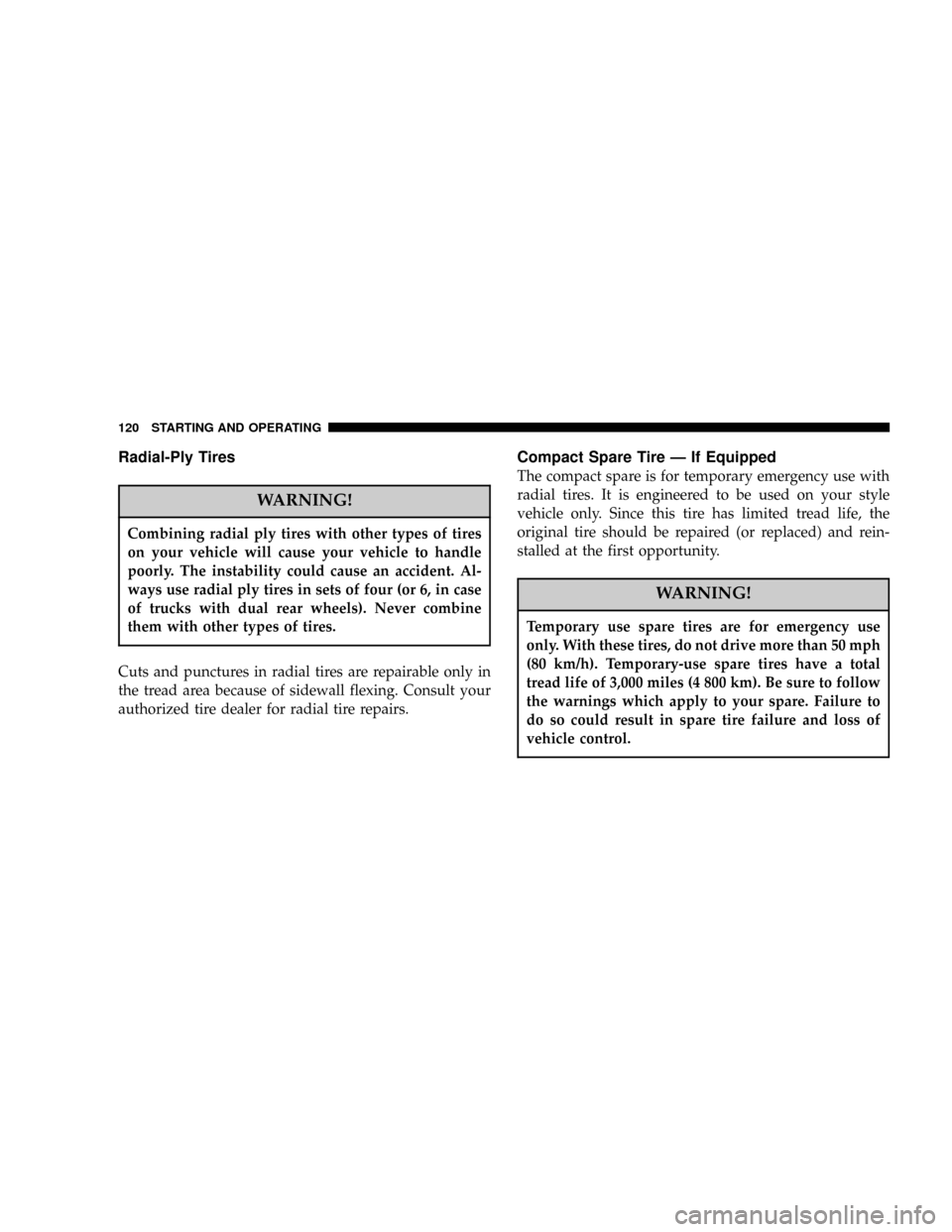warning DODGE VIPER 2004 ZB / 2.G Service Manual
[x] Cancel search | Manufacturer: DODGE, Model Year: 2004, Model line: VIPER, Model: DODGE VIPER 2004 ZB / 2.GPages: 236, PDF Size: 4.18 MB
Page 106 of 236

NOTE:During severe braking conditions, a pulsing
sensation may occur and a clicking noise will be heard.
This is normal, indicating that the Anti-Lock Brake
System is functioning.WARNING!
To use your brakes and accelerator more safely, follow
these tips:
²Do not ªrideº the brakes by resting your foot on
the pedal. This could overheat the brakes and
result in unpredictable braking action, longer
stopping distances, or brake damage.
²When descending mountains or hills, repeated
braking can cause brake fade with loss of braking
control. Avoid repeated heavy braking by down-
shifting the transmission whenever possible.
²Do not drive too fast for road conditions, espe-
cially when roads are wet or slushy. A wedge of
water can build up between the tire tread and the
road. This hydroplaning action can cause loss of
traction, braking ability, and control.
²After going through deep water or a car wash,
brakes may become wet, resulting in decreased
performance and unpredictable braking action.
Dry the brakes by gentle, intermittent pedal ac-
tion while driving at very slow speeds.
106 STARTING AND OPERATING
Page 107 of 236

In the event power assist is lost for any reason (for
example, repeated brake applications with the engine
off), the brakes will still function. The effort required to
brake the vehicle will be much greater than that required
with the power system operating.
If either the front or rear hydraulic system loses normal
capability, the remaining system will still function with
some loss of overall braking effectiveness. This will be
evident by increased pedal travel during application,
greater pedal force required to slow or stop, and activa-
tion of the Brake Warning Lamp during brake use.
NOTE:Your Viper has a very high performance braking
system. The brake pads are a semi-metallic compound
which has been selected for superior fade resistance and
consistent operation. A compromise is that under some
weather and operating conditions, the brakes may squeal
slightly during light brake applications.Brake Pad Break-In
The brakes on your new Viper do not require a long
break-in period, but avoid repeated hard brake applica-
tions from high speeds during initial break-in. Also avoid
severe brake loading such as may be encountered when
descending long mountain grades.
POWER STEERING
The power assisted steering system of your vehicle
provides mechanical steering capability in the event
power assist is lost.
If for some reason the hydraulic pressure is interrupted,
it will still be possible to steer your vehicle. Under these
conditions you will observe a substantial increase in
steering effort.
STARTING AND OPERATING 107
5
Page 116 of 236

WARNING!
Overloading of your tire is dangerous. Overloading
can cause tire failure, affect vehicle handling, and
increase your stopping distance. Use tires of the
recommended load capacity for your vehicle. Never
overload them.
TIRESÐGENERAL INFORMATION
Tire Pressure
Proper tire inflation pressure is essential to the safe and
satisfactory operation of your vehicle. Three primary
areas are affected by improper tire pressure:1. SafetyÐ
WARNING!
Improperly inflated tires are dangerous and can cause
accidents.
²Under inflation increases tire flexing and can result in
tire failure.
²Over inflation reduces a tire's ability to cushion
shock. Objects on the road and chuck holes can cause
damage that results in tire failure.
²Unequal tire pressures can cause steering problems.
You could lose control of your vehicle.
²Over inflated or under inflated tires can affect vehicle
handling and can fail suddenly, resulting in loss of
vehicle control.
²Unequal tire pressures from one side of the vehicle to
the other can cause the vehicle to drift to the right or left.
Always drive with each tire inflated to the recom-
mended cold tire inflation pressure.
116 STARTING AND OPERATING
Page 119 of 236

Tire pressure may increase from 2 to 6 psi (13 to 40 kPa)
during operation. DO NOT reduce this normal pressure
build up or your tire pressure will be too low.
Tire Pressures for High Speed Operation
The manufacturer advocates driving at safe speeds
within posted speed limits. Where speed limits or condi-
tions are such that the vehicle can be driven at high
speeds, maintaining correct tire inflation pressure is very
important. Increased tire pressure and reduced vehicle
loading may be required for high speed vehicle opera-
tion. Refer to original equipment or an authorized tire
dealer for recommended safe operating speeds, loading
and cold tire inflation pressures.
WARNING!
High speed driving with your vehicle under maxi-
mum load is dangerous. The added strain on your
tires could cause them to fail. You could have a
serious accident. Don't drive a vehicle loaded to the
maximum capacity at continuous speeds above 75
mph (120 km/h).
STARTING AND OPERATING 119
5
Page 120 of 236

Radial-Ply Tires
WARNING!
Combining radial ply tires with other types of tires
on your vehicle will cause your vehicle to handle
poorly. The instability could cause an accident. Al-
ways use radial ply tires in sets of four (or 6, in case
of trucks with dual rear wheels). Never combine
them with other types of tires.
Cuts and punctures in radial tires are repairable only in
the tread area because of sidewall flexing. Consult your
authorized tire dealer for radial tire repairs.
Compact Spare Tire Ð If Equipped
The compact spare is for temporary emergency use with
radial tires. It is engineered to be used on your style
vehicle only. Since this tire has limited tread life, the
original tire should be repaired (or replaced) and rein-
stalled at the first opportunity.
WARNING!
Temporary use spare tires are for emergency use
only. With these tires, do not drive more than 50 mph
(80 km/h). Temporary-use spare tires have a total
tread life of 3,000 miles (4 800 km). Be sure to follow
the warnings which apply to your spare. Failure to
do so could result in spare tire failure and loss of
vehicle control.
120 STARTING AND OPERATING
Page 121 of 236

Do not install a wheel cover or attempt to mount a
conventional tire on the compact spare wheel, since the
wheel is designed specifically for the compact spare.
CAUTION!
Because of the reduced ground clearance, do not take
your vehicle through an automatic car wash with the
compact spare installed. Damage to the vehicle may
result.
Tire Spinning
When stuck in mud, sand, snow, or ice conditions, do not
spin your vehicle's wheels above 35 mph (55 km/h).
See the paragraph on Freeing A Stuck Vehicle in Section
6 of this manual.
WARNING!
Fast spinning tires can be dangerous. Forces gener-
ated by excessive wheel speeds may cause tire dam-
age or failure. A tire could explode and injure
someone. Do not spin your vehicle's wheels faster
than 35 mph (55km/h) when you are stuck. And don't
let anyone near a spinning wheel, no matter what the
speed.
STARTING AND OPERATING 121
5
Page 123 of 236

WARNING!
²Do not use a tire, wheel size or rating other than
that specified for your vehicle. Some combina-
tions of unapproved tires and wheels may change
suspension dimensions and performance charac-
teristics, resulting in changes to steering, han-
dling, and braking of your vehicle. This can cause
unpredictable handling and stress to steering and
suspension components. You could lose control
and have an accident resulting in serious injury or
death. Use only the tire and wheel sizes with load
ratings approved for your vehicle.
²Never use a tire with a smaller load index or
capacity, other than what was originally equipped
on your vehicle. Using a tire with a smaller load
index could result in tire overloading and failure.
You could lose control and have an accident.
²Failure to equip your vehicle with tires having
adequate speed capability can result in sudden
tire failure and loss of vehicle control.
CAUTION!
Replacing original tires with tires of a different size
may result in false speedometer and odometer read-
ings.
Alignment And Balance
Poor suspension alignment may result in:
²Fast tire wear.
²Uneven tire wear, such as feathering and one-sided
wear.
²Vehicle pull to right or left.
Tires may also cause the vehicle to pull to the left or right.
Alignment will not correct this condition. See your dealer
for proper diagnosis.
STARTING AND OPERATING 123
5
Page 124 of 236

Improper alignment will not cause vehicle vibration.
Vibration may be a result of tire and wheel out-of-
balance. Proper balancing will reduce vibration and
avoid tire cupping and spotty wear.
Low Tire Pressure (LTP) System
Low Tire Indicator
The Low Tire indicator in the Liquid Crystal Display
(LCD) of the instrument cluster will flash slowly and a
single chime will sound to warn if tire pressure falls
below 20 psi (138 kpa). The indicator will flash more
rapidly and a continuous tone will sound to warn if tire
pressure falls below 14 psi (97 kpa). Seek repair as soon as
possible.
If the indicator stays on and one chime will sound, a
system failure has occurred. See your dealer for service.Although the tires are designed with a ªrun flatº feature
that allows the vehicle to be driven about 50 miles (80
km) at 55 m.p.h. (88 kph), immediate service should be
obtained if the Low Tire indicator is activated.
WARNING!
Do not exceed 55 m.p.h. (88 k.p.h.) if the LOW Tire
indicator in the instrument cluster is illuminated.
Vehicle handling and braking may be reduced. You
could have an accident and be severely or fatally
injured.
NOTE:The ªrun flatº feature eliminates the need for a
spare tire and jack. This vehicle is not equipped with
either a spare tire or jack.
124 STARTING AND OPERATING
Page 130 of 236

WARNING!
Remove the fuel tank filler tube cap (gas cap) slowly
to prevent fuel spray from the filler neck that may
cause injury. The volatility of some gasolines may
cause a buildup of pressure in the fuel tank that may
increase while you drive the vehicle. This pressure
can result in a spray of gasoline and/or vapors when
you remove the cap from a hot vehicle. Removing the
cap slowly allows the pressure to vent and prevents
fuel spray. Never have any smoking materials lit in
or near the vehicle when the fuel tank filler tube cap
(gas cap) is removed or when filling the tank. Never
fill the gas tank while the engine is running.
VEHICLE LOADING
Vehicle Loading Capacities
Front Seat Occupants....................... 2
Luggage....................... 115lbs. (51 kg)
Rated Vehicle Capacity............ 415lbs. (187kg)
TRAILER TOWING
Trailer towing with your Viper is not recommended.
130 STARTING AND OPERATING
Page 131 of 236

WHAT TO DO IN EMERGENCIES
CONTENTS
mHazard Warning Flasher..................132
mIf Your Engine Overheats.................132
mJump-Starting Procedures.................134
mDriving On Slippery Surfaces..............137NTraction............................137
mFreeing A Stuck Vehicle..................138
mTowing A Disabled Vehicle................139
6